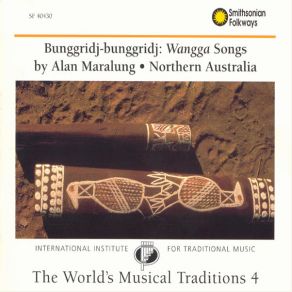The World's Musical Traditions, Vol. 4: Bunggridj-Bunggridj: Wangga Songs: Northern Australia
Download links and information about The World's Musical Traditions, Vol. 4: Bunggridj-Bunggridj: Wangga Songs: Northern Australia by Alan Maralung. This album was released in 1993 and it belongs to World Music genres. It contains 8 tracks with total duration of 49:16 minutes.

|
|
|---|---|
| Artist: | Alan Maralung |
| Release date: | 1993 |
| Genre: | World Music |
| Tracks: | 8 |
| Duration: | 49:16 |
| Buy it NOW at: | |
| Buy on iTunes $7.92 | |
Tracks
[Edit]| No. | Title | Length |
|---|---|---|
| 1. | New Song | 3:56 |
| 2. | Bushfire | 3:34 |
| 3. | Ibis | 5:56 |
| 4. | Green frog | 9:12 |
| 5. | Jabiru | 5:10 |
| 6. | Brolga | 6:10 |
| 7. | Garranan | 6:26 |
| 8. | Minmin Light | 8:52 |
Details
[Edit]Like no other instrument, the reverberating and guttural overtones of the didjeridu have come to signify the "world music" sound. In movie soundtracks and songs by such dissimilar "world music" groups as Trance Mission and Robert Mirabal, the telltale tones of this end-blown aboriginal instrument can be heard and immediately identified. Originally made from eucalyptus branches hollowed out by termites, didjeridus today are manufactured out of everything from cactus limbs to pieces of plastic pipe. Despite its widespread use by serious musicians and novices alike, the didjeridu is not often heard in its original aboriginal Australian context, accompanying a singer. On the Smithsonian release Bunggridj-bunggridj: Wangga Songs, Northern Australia, the didjeridu does in fact appear in this accompanying role. Renowned aboriginal songman Alan Maralung (1925-1990) performs eight songs with the help of didjeridu and staccato clapstick accompaniment. Maralung was given these songs in a dream by the spirit Bunggridj-bunggridj. They belong to a larger genre of songs known as wangga, which are performed throughout northern Australia by aborigines. Wangga are personally owned dance-songs that can be performed publicly in both non-ceremonial activities and such ceremonial contexts as circumcisions and purification rites. Recorded by Allan Marett two years before Maralung's death, these songs display the songman's improvisatory singing style and his use of clapsticks, as well as Peter Manaberu's tasty didjeridu playing. A superb set of field recordings that presents the rarely heard sounds of traditional aboriginal songs, Maralung's Bunggridj-bunggridj: Wangga Songs, Northern Australia will most likely appeal to listeners who are not afraid of opening up their minds to a world of new sounds and styles. A 44-page booklet written by Marett and Linda Barwick accompanies the CD and does much to elucidate the meaning of these cherished songs.